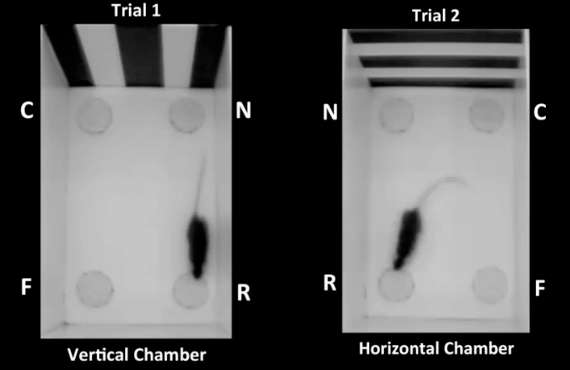Researchers show that mental 'map' and 'compass' are two separate systems

If you have a map, you can know where you are without knowing which way you are facing. If you have a compass, you can know which way you're facing without knowing where you are. Animals from ants to mice to humans use both kinds of information to reorient themselves in familiar places, but how they determine this information from environmental cues is not well understood.
In a new study in mice, researchers at the University of Pennsylvania have shown that these systems work independently. A cue that unambiguously provided both types of information allowed the mice to determine their location but not the direction they were facing.
The study, published in the Proceedings of the National Academy of Sciences, was conducted by graduate students Joshua Julian and Alexander Keinath, assistant professor Isabel Muzzio and professor Russell Epstein, all of the Department of Psychology in Penn's School of Arts & Sciences.
"When you're lost," Epstein said, "how do you reestablish your bearings? People have been studying this for more than 25 years, but they have not focused on the fact that place recognition, figuring out where you are, and heading retrieval, figuring out which way you're facing, could be two separate systems."
The team's experiment was an updated version of one of the original studies of reorientation, conducted at Penn by psychologists Ken Cheng and Randy Gallistel in 1986, which showed that rats use the shape of a room, but not other kinds of informative features, to get their bearings.
To show this, the researchers in the 1986 study used a small rectangular room that had cups in each corner in which food could be hidden. From the bird's-eye view of the researchers, the food was always hidden in the northwest corner. From the rat's perspective, markings on the walls should have distinguished between the corners, enabling them to find the northwest corner every time. After researchers spun the rats around to get them to lose their bearings, however, the rats were equally likely to search in the southeast as they were in the northwest. This told the researchers that the rats' "compasses" were calibrated to the geometry of the room. The rats were essentially learning that the food was always hidden in a corner where the long wall was on their left but apparently couldn't use the markings on the walls to tell which short wall was which.
"These earlier reorientation studies," Julian said, "taught us how the mental compass worked but did not tell us about the mental map. Because they were performed in single chamber environments in which there was no ambiguity about where the animal was in the world, they didn't tell us which of the environmental cues were used to recover the map. They only told us that geometry was used to recover the compass."
In the new version of the experiment, mice were trained on the location of food in two different rectangular rooms. These rooms were identical to each other, except the markings on their north walls were decorated with different features, vertical stripes in one, horizontal stripes in the other.
"In order for the mice to find the reward," Keinath said, "they must now solve two problems: first, which chamber am I in? And second, which way am I facing? In theory, the features could be used to solve both these problems. They could tell you both which room you're in and which way you're facing. In practice, however, that's not what we find."
To test how the mice made use of these two pieces of information, the food was hidden in different corners in the two rooms. In the vertical-stripe room, the food was always in the northwest corner, in the horizontal-stripe room, it was always in the northeast.
If mice had a single reorientation system that acted as both map and compass, the mice would have been able to use the stripes to find the food every time. However, they still made the same kind of geometric error seen in the original reorientation experiment.
In the vertical-stripe room the mice would guess between the northwest and southeast corners, and in the horizontal-stripe room they would guess between the northeast and southwest. This showed that the wall markings provided the map of which of the two rooms the mouse was in, but only geometric features were used to set the compass that told the animal which direction was which.
"The way you figure out if two mental operations are independent," Epstein said, "is that you find something that affects one and not the other. Because the mice go to different sets of corners in different rooms, we know they are using the stripes on the north wall to determine which room they are in. But despite the fact that the striped wall could also tell them which way they are facing, they don't use it for that."
Future work will involve running similar experiments while gathering direct brain recordings from the mice's "place cells." The discovery of place cells and of related "grid cells" was the subject of the 2014 Nobel Prize in Physiology and Medicine; combined, they form the basis of the brain's positioning system.
"We are currently recording from the hippocampus," Muzzio said, "the brain region that contains place cells, to determine how spatial representations change when animals reorient in space. This will allow us to explore how the brain maps change when animals are using geometry versus cues."
More information: Place recognition and heading retrieval are mediated by dissociable cognitive systems in mice, Joshua B. Julian, 6503–6508, DOI: 10.1073/pnas.1424194112















